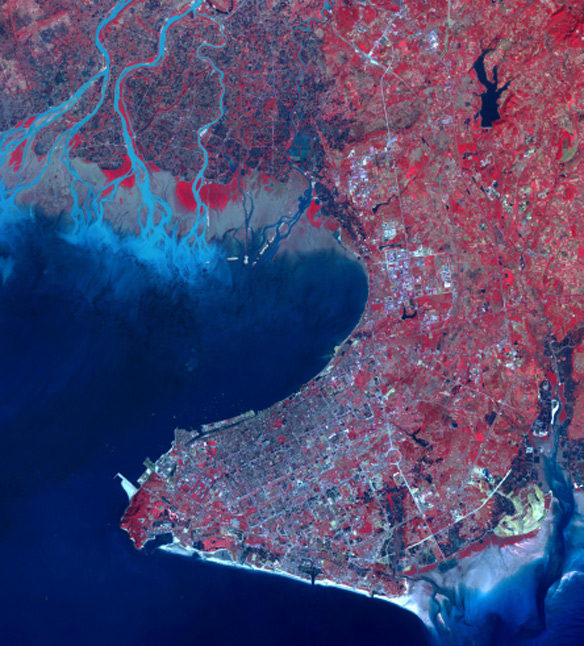
Beihai is a city in the south of Guangxi, People’s republic of China. It is a seaport on the north shore of the Gulf of Tonkin (Vietnam), also known as the Beibu Gulf (China).
The Gulf is defined in the west by the northern coastline of Vietnam, in the north by China’s Guangxi province, and to the east by China’s Leizhou Peninsula and Hainan Island.
Historically it has been an international trade port for many provinces to the north. From a population of about 150,000 in 1990, Beihai has grown to over 1,600,000 in 2013. Between the years 2006 and 2020, Beihai is predicted to be the world’s fastest growing city. Captions source: NASA
Excerpts;
The vast tracts of mangrove forest in the Beibu Gulf of Guangxi Zhuang Autonomous Region have been almost erased by the immense construction of marine reclamation lands and industrial plants.
Simply because mangrove trees can hardly yield any profitable economic returns, they have been cut down to make place for the development of more profitable industries, said Fan.
From 2000 to 2007, Beihai, Fangchenggang and Qinzhou reclaimed 962 hectares of land from the sea area. However, during the following five years — 2008-2012 — the land reclamation soared to a total of 5,108 hectares in the same cities.
An official report on the environmental conditions of the coastal area issued in Guangxi has shown that the sea water near the shore has been severely contaminated by the pollutants majorly consisting of inorganic nitrogen, petroleum related substances and reactive phosphate.
Ocean areas near the Beibu Gulf receive 400-million-ton household wastewater as well as 100-million-ton industrial sewage each year…
Crisis Response: When Trees Stop Storms and Deserts in Asia; WRI (02-25-2016)
A history of deforestation has made Asian nations like Vietnam, China and South Korea especially vulnerable to coastal storms, floods and sandstorms. Yet just as these nations have experienced similar crises, they’re also all pursuing a solution—restoring degraded landscapes…
Coastal Mangrove Squeeze in the Mekong Delta, Journal of Coastal Research (03-16-2015)
Greenbelt Reports / TVE Asia Pacific
The Greenbelt Reports (GBR) is a multi-media, Asian regional educational project to document the conservation challenges involving mangroves, coral reefs and sand reefs, collectively called ‘greenbelts’ in recognition of their natural protective role against wave action and anticipated climate change impact.
Destruction of Mangroves Costs up to US$42 billion in Economic Damages Annually – UNEP Report (10-14-2014)
The world is losing its mangroves at a faster rate than global deforestation, the United Nations revealed, in a new report “Importance of Mangroves: A Call to Action,” adding that the destruction of the coastal habitats was costing billions in economic damages and impacting millions of lives…
Great Wall Of Sand: Chinese Mischief at Mischief Reef, The New York times (04-12-2015)
Built on Sand: Singapore and the New State of Risk, Harvard Design Magazine (09-07-2015)
Preventing Ecocide in South China Sea, Guardian UK (07-20-2015)
Such Quantities of Sand, The Economist (07-27-2015)
Asia’s mania for reclaiming land from the sea spawns mounting problems…









